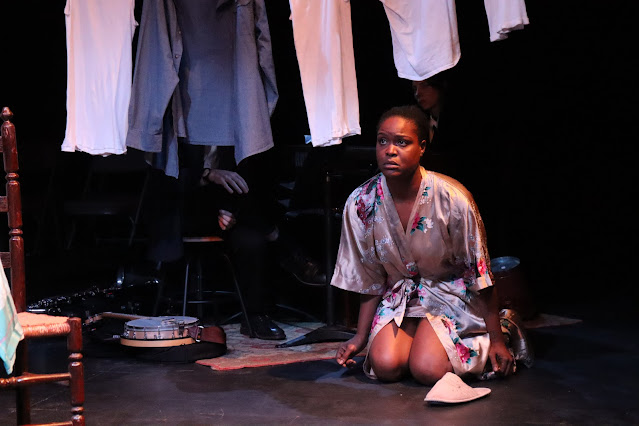Review: The Postapocalypse Has Never Sounded Better than in "The End of All Flesh"
The End of All Flesh
Written by Greg Kotis
Directed by Avery Rose Pedell
Presented by Theater of the Apes and FRIGID New York at the wild project
195 E 3rd St., Manhattan, NYC
April 2-20, 2025 [UPDATES, 1 and 28 May 2025: The production has been extended and will be presented as part of the “Monday Night Musicals” double-feature at The Magnet (254 W 29th St, New York, NY 10001) with performances on May 5 at 6:30 p.m., May 19 at 6:30 p.m., June 2nd at 6:30 p.m., June 9th at 6:30 p.m., June 16th at 6:30 p.m., and June 23rd at 8 p.m. Tickets $25 are available for advance purchase at www.magnettheater.com.]
 |
| Greg Kotis, Maithili Ginde, Sammy Pignalosa, and Ayun Halliday. Photo by Pam Rice. |
The show is consistently self-aware, talking about itself as a show taking place in the future and the audience as spectators from the past, and we're initially oriented by married couple Pa (playwright Greg Kotis) and Ma (Ayun Halliday), the latter cheerfully disemboweling a pig (a marvelous creation by Sandye Renz) throughout the scene. Ma and Pa, as we come to learn, live on a mountaintop since only there is the heat weak enough for plants and animals to survive. This future, without civilization, without electricity, has, they point out, more in common with the distant past than the audience's present–and at one point, the characters get sidetracked by a discussion of different philosophers' conceptions of the "state of nature," exemplary of The End of All Flesh's razor-sharp sense of humor. Living with Ma and Pa is their son, Boy (Sammy Pignalosa), who is in love, much to Pa's disapproval, with Girl (Maithili Ginde), despite her formidable survivalist skills. As Boy and Girl commit to marrying, plans go awry, past wrongs (fittingly) come to bear, and questions of what kind of world we want (or fear) to see come to the fore.
 |
| Greg Kotis. Photo by Pam Rice. |
In addition to Kotis's banjo playing, the production features a live trio, The Previouslies–music director Melody Allegra Berger on fiddle, assistant music director Stephen Anthony Elkins on acoustic guitar, and Marty Isenberg on upright bass–and the show's songs range from the prettiness of "A Very Sad Song" to the insouciance of "What a Woman Can Do" to the exuberance of the immediately catchy late number "The Beseechments." The cast deliver terrific, winning vocal performances, with Ginde providing some especially impressive moments, and they create a vivid group of characters. Halliday's Ma is a consistent scene stealer, trying the best to establish concord while nurturing her fantasies of how life (or the afterlife) could be; Kotis gives us a hysterical high point in which his generally taciturn Pa talks and, in "the Slicin' Knife," sings about mythological patriarchs; and Pignalosa infuses Boy with an underlying sweetness that pairs perfectly with Ginde's harder-headed Girl. At the end of our time with this captivating clan, who, in another self-reflective moment, claim "artists and intellectuals" among their ancestors, The End of All Flesh give us some hope that if we value the right things, such as love more than power and those artists and intellectuals more than wealthy capitalists, the coming catastrophes might at least be mitigated. In keeping with such choices, we surely should value the joy and catharsis to be found in The End of All Flesh.
-John R. Ziegler and Leah Richards
More reviews from the 2025 New York City Fringe Festival:



Comments
Post a Comment